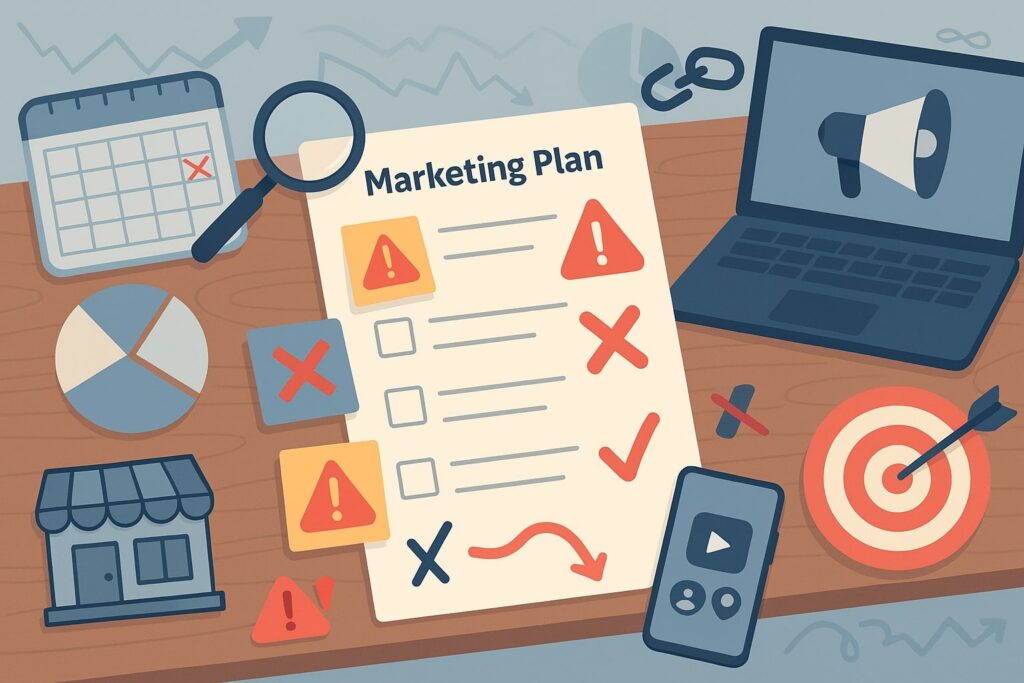
How to Write a Small Business Marketing Plan
Creating a marketing plan is essential for any small business owner. A marketing plan is a strategic roadmap that explains how you will communicate and promote your products or services to your target audience.
Rather than haphazardly posting on social media or running ads without direction, a well-crafted marketing plan ensures that all efforts align with your goals. In fact, a marketing plan not only identifies who your customers are and what their needs are, but it also clarifies how your offerings differ from competitors and acts as a roadmap for sales, branding, and messaging.
In practical terms, having a plan forces you to “do the math” on your goals (for example, if you need $100,000 in sales, how many customers or leads are required) and allocates resources accordingly. This disciplined approach helps avoid wasted effort or “scope creep,” keeping everyone on the same page.
A marketing plan is also a living document. It should be clear and accessible so that your team, stakeholders, and future hires can understand and execute it. For instance, well-written plans often start with a brief executive summary that highlights the business’s mission, key goals, and overarching strategy.
The plan will then typically cover the target market, competitive analysis, marketing objectives, the mix of strategies and tactics (pricing, promotions, channels), the budget, and finally how you will monitor and adjust the plan.
In short, a marketing plan ties your daily marketing tasks back to business outcomes, helping you focus every dollar on activities that support your goals.
Why a Marketing Plan Is Crucial

- Identifies Your Target Market: A marketing plan forces you to specify who your ideal customers are (age, demographics, needs) and what problems your product or service solves for them.
Without this focus, marketing dollars can be wasted on the wrong audience. As one source notes, “a company’s best customers… should be in the target market” and targeting correctly makes every marketing dollar work harder. - Clarifies Your Value Proposition: By outlining your competitive advantage or unique selling proposition (USP), the plan makes clear why customers should choose you over competitors.
For example, you might compete on lower price, higher quality, or a better customer experience. - Sets Measurable Goals: A plan makes you define specific, realistic objectives (sales, market share, website traffic, etc.) instead of guessing. Doing the math on objectives (e.g. how many leads you need to hit a sales target) helps align your marketing strategy with your revenue goals.
As one marketing expert explains, turning a revenue goal into a “metric to start with” (e.g. leads needed at a given close rate) allows you to build a concrete action plan. - Coordinates Strategy and Tactics: Rather than random posts and ads, a marketing plan documents which channels (social media, email, SEO, local events, etc.) you will use and how they fit together.
It becomes the hub that links broad strategies (branding, content, SEO) with specific tactics (e.g. a Facebook campaign in Q2). This alignment helps everyone stay on strategy and prevents wasting resources on unrelated ideas. - Improves Efficiency and ROI: Focusing on a documented plan increases efficiency by eliminating guesswork. For instance, the plan can highlight areas to invest more (e.g. digital ads or content marketing) and areas to trim (channels that don’t perform).
According to business analysts, a marketing plan can help “eliminate waste by building efficiency,” ensuring limited resources yield the greatest return. - Provides Accountability and Continuity: A written plan establishes timelines and responsibilities so team members know who does what, by when.
It holds the marketing team accountable and makes it easier to report progress to stakeholders. Additionally, if people change roles or new hires come on board, the plan serves as a guide to maintain consistency. - Helps Manage Risk: Planning in advance forces you to consider potential roadblocks and contingencies. This preparation reduces the risk of costly mistakes (such as launching a campaign that flops) and enables quicker pivots when market trends shift.
Plans should be reviewed regularly—often annually—to adapt to new insights, customer feedback, or seasonal changes.
In short, without a marketing plan, a small business can “move at great speed… but in the entirely wrong direction”. By contrast, a clear plan acts as a compass, giving every marketing decision purpose and clarity.
Key Components of a Small Business Marketing Plan

While formats vary by business, most effective marketing plans include the following sections:
| Section | Contents / Purpose |
|---|---|
| Executive Summary | A 1–2 page overview of your marketing plan’s highlights – mission, top goals, and key strategies. It orients readers to the most important points (useful for busy stakeholders). |
| Mission & Vision | Your company’s mission (why you exist) and vision (long-term purpose) to ground the plan in core values. |
| Target Market | Detailed description of your customers (demographics, needs, behaviors) and market size/trends. Include customer personas or segments you intend to reach. |
| Competitive Analysis | An assessment of key competitors and your Unique Selling Proposition (USP) – what makes you stand out. List competitors’ strengths and gaps and how you will differentiate (e.g. better quality, price, or service). |
| Products/Services | Clear description of what you offer and the value to customers. Explain how your product/service solves a problem or meets a need, and any key features. |
| Marketing Goals | Specific, measurable objectives (for example, “gain 500 new customers” or “increase website traffic 30%”). Goals may include sales targets, market share, customer retention, brand awareness, etc. Align goals with overall business objectives. |
| Strategy & Tactics | The marketing strategy is the broad approach (your positioning, marketing mix, and branding), while tactics are the actual actions to execute it. Describe the marketing channels and tactics you will use (e.g. content marketing, SEO, email campaigns, social media, PR, local events, paid ads). Explain why these choices match your target audience. |
| Pricing & Promotions | Outline your pricing strategy (how you price products to be competitive and profitable) and any planned promotions, discounts or bundles. Ensure pricing aligns with your positioning and covers costs. |
| Budget & Financials | A detailed budget for marketing activities. List expected expenses (advertising, tools, design, printing, labor, etc.) and project returns. A comprehensive budget not only ensures feasibility of your plan but also allows you to track ROI. |
| Action Plan & Timeline | Step-by-step plan of what will be done, who is responsible, and when. Include a timeline (e.g. a calendar or Gantt chart) of marketing campaigns and key milestones. Having a schedule keeps efforts on track and ensures tasks are completed in time. |
| Metrics & Monitoring | Specify how you will measure success (KPIs). Describe reporting routines (weekly or monthly reports) and review mechanisms. This “control” section explains how you will track performance (sales data, web analytics, customer feedback) and adjust the plan as needed. |
Each section should flow logically: the executive summary first, then background/analysis, goals, strategies, and the implementation details.
Some businesses also include a SWOT analysis (Strengths, Weaknesses, Opportunities, Threats) in the situation analysis to highlight internal and external factors. For example, Sage advice recommends including a SWOT within the market context to pinpoint where the business can excel.
Planning Tips for Key Components
- Executive Summary: Write this section last, after you’ve completed the other parts. Ensure it concisely encapsulates the plan’s essence – often it’s the only part some people read.
- Target Market & Personas: Be as specific as possible about who your ideal customers are. You might create customer personas with demographics, pain points, and behaviors.
(One marketing guide highlights making detailed personas with demographics and interests to understand your audience better.) - USP and Positioning: Clearly state what sets your offerings apart. Your USP should answer why a customer would pick you over the competition. For instance, if most competitors sell generic products, your USP might be higher quality or local craftsmanship.
- Budget: No plan is complete without it. Allocate costs across all planned activities, including smaller items like content creation or event fees. Accurate budgeting prevents overspending and helps calculate ROI later.
- Timeline: Use a marketing calendar to schedule campaigns and tasks. For example, list each campaign’s start/end dates and key deliverables. Assigning deadlines keeps the team accountable and ensures coordinated efforts.
By covering these elements, your marketing plan will serve as a comprehensive guide for your marketing and sales efforts.
Steps to Write Your Marketing Plan

Below is a step-by-step process to create a marketing plan for a small business. These steps integrate best practices from marketing experts:
- Assess Your Current Situation (Research): Start with a snapshot of where your business stands. Conduct a SWOT analysis (Strengths, Weaknesses, Opportunities, Threats) to understand internal and external factors.
Review past marketing results and market trends. This situational analysis helps you identify what has worked and what challenges you face. For example, one guide advises basing your plan on “what the marketer has learned about the marketplace”. - Define Your Target Audience: Research and describe your ideal customers. Identify demographic factors (age, location, income) and psychographic factors (values, interests, behaviors). This may involve surveys, interviews, or analyzing customer data.
Knowing your audience well is crucial – as one small-business guide notes, “who your customers are and what do they want” guides your messaging. Also consider segmenting your audience into groups (for example, local buyers vs. online shoppers) to tailor your approach. - Set Clear, Measurable Goals: Decide what you want to achieve with marketing. Goals should be specific and measurable – e.g. “Increase online sales by 25% in the next year” or “Generate 200 qualified leads per month.”
Your goals might include sales targets, customer acquisition, website traffic, social media growth, or brand awareness metrics. Make sure these goals align with overall business objectives (revenue, expansion, etc.) and are realistic given your budget and resources. - Develop Your Strategy (USP and Positioning): Outline how you will achieve those goals. Determine your brand positioning and unique selling proposition (USP).
For instance, you might position yourself as the most eco-friendly provider, or the premium-quality brand, or the most affordable option.
Document your key messaging themes. In other words, plan your core marketing strategy – how you will differentiate yourself in the market. - Choose Marketing Tactics and Channels: Decide which tactics and channels will reach your target audience effectively.
This is your marketing mix. Common tactics for small businesses include content marketing (blogs, videos), social media campaigns, email newsletters, search engine optimization (SEO), online advertising (Google Ads, social ads), and local/traditional advertising (flyers, radio, events).
For example, Shopify recommends launching a mix of digital ads, social posts, influencer partnerships, traditional ads, and content like blogs or explainer videos. Select the tactics that fit your audience and budget.
For each, describe what you will do (e.g. run a Facebook ad campaign) and why it should work for your customers. - Set a Marketing Budget: Outline how much you will spend on each tactic. Include costs for advertising spend, design, tools, agency fees, and manpower.
An itemized marketing budget ensures you don’t overspend and helps you focus on the most impactful activities. A good budget supports a positive ROI – one checklist notes that “no marketing plan is complete without a budget that breaks down costs”. - Create an Action Plan and Timeline: Break down tactics into specific actions with deadlines. For example: * “Week 1–2: Design new email template; Week 3: Launch email campaign.” * Assign responsibility for each task.
A detailed timeline keeps the rollout organized. suggests creating action plans that include steps to enact your strategy and identifying roadblocks in advance. Use this plan to coordinate your team’s work and monitor progress. - Determine Metrics and Reporting: Decide how you will measure the success of each tactic. Common metrics include conversion rates, website traffic, sales volume, engagement, and return on ad spend.
Set up tools (like Google Analytics, email reports, or sales tracking) to collect data. Plan to review these metrics regularly (monthly or quarterly) and adjust tactics if needed.
As one marketing guide emphasizes, “marketing is not a set-it-and-forget-it proposition” – you must continually monitor and tweak your plan based on what works. - Implement, Monitor, and Adjust: Finally, execute your plan. Launch your campaigns and keep an eye on performance. Hold regular check-ins with your team (weekly or monthly) to review metrics and pivot if something isn’t working.
One expert recommends weekly progress reports and meetings to keep everyone on track. Make updating the plan an ongoing habit: for instance, review it annually or when major market changes occur.
By following these steps, you build a complete, actionable marketing plan tailored to your business. Many agencies and resources are available if you need help with specific steps.
For example, free templates (from SBA, SCORE, or sites like ) can simplify the process, and digital marketing tools can assist with data tracking and campaign execution.
Common Mistakes to Avoid

When writing your marketing plan, be careful to avoid these common pitfalls:
- Unrealistic Budgets: Don’t underestimate how much your tactics will cost. An overly optimistic budget may leave you unable to fully execute the plan.
- Chasing Quantity Over Quality: More marketing efforts don’t always mean better results. Focus on meaningful campaigns that reach the right audience, rather than spreading yourself too thin. (For example, blasting irrelevant social posts can yield unqualified leads.)
- Skipping Testing: Avoid launching big campaigns blindly. Instead, test your ads or messages on a small scale first. This prevents wasting resources on approaches that might not resonate.
- Ignoring Feedback and Data: Don’t disregard customer feedback or performance data. If a campaign is underperforming or customers raise complaints, use that information to improve your offerings and messaging.
- Overpromising: Be careful not to set expectations that your product or service can’t meet. Overstating benefits can damage your reputation.
- Ignoring Seasonality and Trends: Failing to account for seasonal demand or market trends can cost opportunities. For example, a retailer should ramp up marketing before the holiday season, not after.
- Not Updating the Plan: A marketing plan should be a living document. If you set it and never revisit it, you miss chances to refine strategies. Regularly (at least annually) review and update your plan to reflect what you’ve learned and any market shifts.
Avoiding these mistakes will help your marketing plan be more realistic and effective.
Tools and Resources
Luckily, you don’t have to start from scratch. There are many tools, guides, and templates to help small businesses write marketing plans:
- Templates: Organizations like the U.S. Small Business Administration (SBA) and SCORE offer free marketing plan outlines and examples.
provides a free customizable marketing plan template that walks you through each section. Smart business sites (e.g. Smart Insights) also offer downloadable templates and plan generators for benchmarking strategies. - Software and Apps: Marketing plan software (such as Marketing Plan Pro, LivePlan, or online SaaS tools) can guide you through creating financial projections and budgets. CRM or project management tools can help implement and track your plan.
- Guides and Examples: Reading sample plans can give ideas. For instance, case studies often show good marketing plans that include concise executive summaries and clear goals.
(A well-designed example might summarize the problem, solution, market, competition and USP, then list milestones and target metrics for accountability.) - Hiring Help: If writing a plan feels overwhelming, consider hiring a marketing consultant or agency for strategic guidance.
You could also find local small business mentors through SCORE who can review your plan. Many agencies also offer one-off workshops for plan development. - Online Marketing Tools: Tools like Google Analytics (for web metrics), social media management platforms, and email marketing software can execute and measure parts of your plan.
For budgeting and timelines, spreadsheet templates or tools like Smartsheet can organize costs and schedules.
When using templates or tools, remember to customize the content to your unique business and market. Templates are just a starting point – the best marketing plan is one tailored to your customers, goals, and resources.
FAQs
Q: What is a marketing plan and why do I need one for my small business?
Answer: A marketing plan is a written roadmap that details how you will promote your products or services to your target audience. It covers your goals, strategies, budget, and tactics. You need it because it “drives action and points the way” for growth. Without a plan, you risk wasted marketing spend, confused messaging, and missed opportunities.
Q: What should be included in a small business marketing plan?
Answer: Key elements include an executive summary (overview), your company mission/vision, target market analysis, competitive analysis/USP, marketing goals, the strategy and tactics you’ll use, budget and financial projections, an action plan/timeline, and how you’ll measure results. Essentially, document who you’re selling to, what you’re selling, how and where you’ll sell it, and how you’ll measure success.
Q: How often should I update my marketing plan?
Answer: Marketing plans should be reviewed regularly—at least annually, often quarterly—to stay current. Experts advise treating the plan as a “living document” that evolves with the business. Updating it yearly (or whenever market conditions change) keeps it relevant.
Q: What common mistakes should I avoid?
Answer: Avoid these pitfalls: underestimating costs (set realistic budgets), overloading on too many channels (focus on quality over quantity), skipping A/B testing, ignoring customer feedback, and failing to revise the plan. Also make sure not to promise more than you deliver. Regularly measuring ROI and listening to customers helps avoid these errors.
Q: Can I use a template or tool for my marketing plan?
Answer: Yes. Many free templates exist (from SBA, SCORE, , etc.) that outline the sections of a marketing plan. Templates can save time but should be customized. Online tools and software (or agency help) can also assist with financial projections and tracking metrics. Whatever format you use, the content must reflect your unique business needs.
Conclusion
Writing a small business marketing plan may seem like a big task, but it pays off by giving your business direction and coherence. A good plan forces you to understand your customers, set realistic goals, and choose the most effective strategies and channels.
It aligns your marketing activities with your business vision and budget. By following the steps outlined above, including market research, goal-setting, strategy selection, and budgeting, you can create a plan that will help you grow your business rather than chase your tail.
Remember to keep your plan clear and up-to-date – revisiting it regularly ensures it remains relevant as your business and market evolve. With a solid marketing plan in hand, a new entrepreneur or local business owner can confidently move forward knowing their promotional efforts are intentional, measurable, and aligned with success.